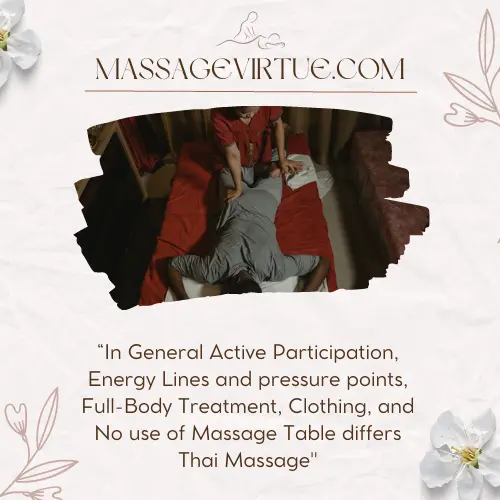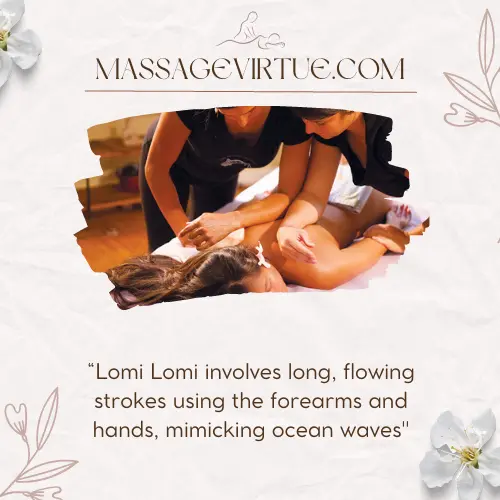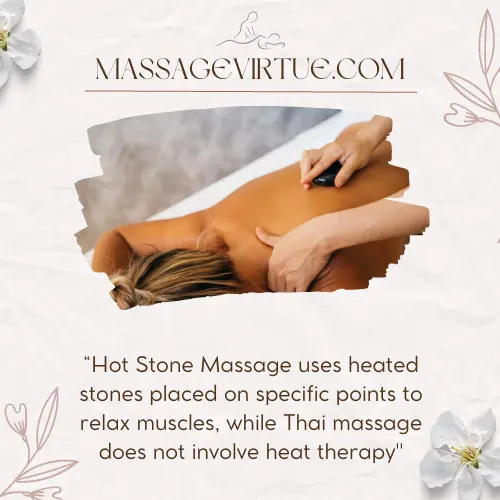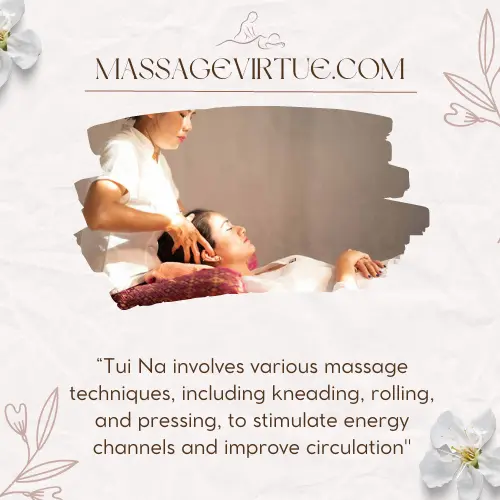Massage therapy is a universal practice embraced for its multitude of health benefits, offering relaxation, stress relief, and physical well-being.
However, not all massages are created equal.
In this article, we will delve into the distinct characteristics of Thai massage to know what is different about a Thai massage by comparing it to a variety of other popular massage styles from around the world.
What Is Different About A Thai Massage Than Other Massages?
Thai massage stands out among various massage therapies due to its unique approach.
Unlike many other forms of massage that primarily involve passive relaxation, Thai massage is a holistic practice deeply rooted in traditional Thai medicine.
Here are some key differentiators:
- Active Participation: Thai massage is often described as “lazy yoga” because it involves both the practitioner and the recipient actively moving and stretching the body. This active participation distinguishes it from other more passive forms of massage.
- Energy Lines and Pressure Points: Thai massage focuses on the body’s energy lines (Sen) and pressure points, similar to acupuncture and shiatsu. By applying pressure along these lines and points, it aims to restore the body’s natural energy flow.

- Full-Body Treatment: Thai massage is a comprehensive full-body treatment. Instead of isolating specific areas, it incorporates stretches and movements that address the entire body, enhancing flexibility and mobility.
- Clothing: Recipients of Thai massage remain fully clothed in loose, comfortable attire. There’s no need for oils or lotions, making it a convenient choice for those who prefer to avoid direct skin contact.
- No Massage Table: Thai massage is typically performed on a mat on the floor rather than a massage table. This setup allows for a wider range of movements and stretches.
Now, let’s explore how Thai massage differs from specific other forms of massage
Thai Massage vs. Swedish Massage
While both Thai and Swedish massages offer relaxation and stress relief, they differ significantly in approach:
- Technique: Swedish massage primarily uses long gliding strokes, kneading, tapping, and circular movements with the goal of promoting relaxation. In contrast, Thai massage combines acupressure, stretching, and passive yoga-like movements to release tension and improve energy flow.
- Clothing: In Thai massage, you remain fully clothed in comfortable attire, whereas Swedish massage typically involves disrobing and lying directly on a massage table.
- Focus: Swedish massage focuses on specific muscle groups and often employs massage oils. Thai massage, on the other hand, aims to balance the body’s energy and treats the entire body through stretches and pressure points.
Thai Massage vs. Shiatsu Massage
- Origins: Thai massage originated in Thailand, while Shiatsu massage has its roots in Japan.
- Technique: Thai massage involves stretching and passive movements along with acupressure, while Shiatsu relies on finger pressure on specific points (similar to acupuncture).
- Fully Clothed: Both Thai and Shiatsu massages are typically performed with the recipient fully clothed.
- Philosophy: Thai massage is based on traditional Thai medicine and energy lines (Sen), whereas Shiatsu is inspired by traditional Chinese medicine’s principles and meridians.
- Pressure: Thai massage involves more dynamic stretching, while Shiatsu uses rhythmic pressure. The pressure in Thai massage varies based on the recipient’s comfort and flexibility, while Shiatsu typically follows specific sequences and pressure points.
Thai Massage vs. Deep Tissue Massage
- Pressure: Deep Tissue Massage focuses on applying firm pressure to reach the deeper muscle layers, often to alleviate chronic muscle tension or injuries. Thai massage utilizes various techniques, including stretching and acupressure, without the same level of intense, sustained pressure.
- Clothing: Thai massage recipients remain clothed, whereas Deep Tissue Massage often requires undressing to access specific muscle groups.

- Treatment Goals: Thai massage aims to balance energy flow, enhance flexibility, and promote relaxation. Deep Tissue Massage is primarily therapeutic, addressing specific musculoskeletal issues.
- Technique: Thai massage incorporates stretching and passive movement, while Deep Tissue Massage employs techniques like friction, kneading, and cross-fiber friction.
Thai Massage vs. Aromatherapy Massage
- Essential Oils: Aromatherapy Massage involves the use of essential oils for their therapeutic benefits. Thai massage does not typically use oils, focusing more on stretching and acupressure.
- Technique: Thai massage includes active stretches and movements, while Aromatherapy Massage involves various massage techniques with the added benefit of essential oils for relaxation and aromatherapy benefits.
- Purpose: Aromatherapy Massage aims to promote relaxation, relieve stress, and enhance mood through the use of specific essential oils. Thai massage seeks to balance energy, enhance flexibility, and alleviate tension through stretches and pressure points.
Thai Massage vs. Ayurvedic Massage
- Origins: Thai massage has its roots in Thailand, while Ayurvedic massage is deeply connected to the ancient healing system of Ayurveda, originating in India.
- Philosophy: Thai massage focuses on energy lines (Sen) and passive yoga-like stretches. Ayurvedic massage is grounded in Ayurvedic principles, balancing the individual’s doshas (body types) and using specific oils.
- Technique: Thai massage uses stretching, acupressure, and joint mobilization, while Ayurvedic massage involves a variety of strokes, marma point stimulation, and warm oil application.
- Oils: Ayurvedic massage relies heavily on the use of medicated or therapeutic oils to address specific imbalances, while Thai massage typically does not involve oil application.
Thai Massage vs. Lomi Lomi Massage
- Origins: Traditional Hawaiian Temple Bodywork, also known as Lomi Lomi Nui originates from Hawaii, while Thai massage comes from Thailand.
- Technique: Lomi Lomi involves long, flowing strokes using the forearms and hands, mimicking ocean waves. Thai massage incorporates stretching, acupressure, and yoga-like movements.

- Purpose: Lomi Lomi is often seen as a spiritual and rejuvenating experience, while Thai massage aims to balance the body’s energy and improve physical well-being.
- Clothing: In both Lomi Lomi and Thai massage, recipients typically remain clothed in comfortable attire.
Thai Massage vs. Balinese Massage
- Origins: Balinese massage is rooted in the Indonesian island of Bali, while Thai massage comes from Thailand.
- Technique: Balinese massage combines elements of acupressure, aromatherapy, and gentle stretching. Thai massage incorporates more dynamic stretching and acupressure.
- Oils: Balinese massage frequently involves the use of aromatic oils, while Thai massage does not use oils.
- Purpose: Balinese massage aims to relax and rejuvenate, often using aromatic oils for therapeutic effects. Thai massage focuses on balancing energy flow and enhancing flexibility.
Thai Massage vs. Reflexology
- Focus: Thai massage treats the entire body through stretches and acupressure. Reflexology focuses specifically on the feet and hands, targeting reflex points believed to correspond to various organs and systems in the body.
- Technique: Thai massage involves a wide range of movements and stretches, while Reflexology primarily uses thumb and finger pressure on reflex points.
- Purpose: Thai massage seeks to balance energy and improve flexibility. Reflexology aims to promote relaxation and enhance overall well-being through the feet and hands.
Thai Massage vs. Hot Stone Massage
- Heat Therapy: Hot Stone Massage uses heated stones placed on specific points to relax muscles, while Thai massage does not involve heat therapy.
- Technique: Thai massage relies on stretching and acupressure, while Hot Stone Massage combines massage techniques with the use of hot stones.

- Clothing: Thai massage is typically performed with the recipient fully clothed, while Hot Stone Massage often involves undressing and the use of draping.
Thai Massage vs. Lanna Tok Sen Massage
- Origins: Lanna Tok Sen Massage originates from Northern Thailand (Lanna region), much like Thai massage.
- Technique: Lanna Tok Sen Massage uses a wooden mallet and wedge to rhythmically tap along the body’s energy lines (Sen) and muscle meridians, similar to Thai massage’s use of acupressure and stretching.
- Purpose: Both Lanna Tok Sen and Thai massage aim to relieve muscle tension, promote relaxation, and balance the body’s energy flow.
- Sensations: Lanna Tok Sen’s tapping creates a unique rhythmic vibration, while Thai massage’s stretching and acupressure produce a different tactile experience.
Thai Massage vs. Abhyanga Massage
- Origins: Abhyanga Massage is rooted in Ayurveda, an ancient Indian healing system, while Thai massage comes from Thailand.
- Technique: Abhyanga involves warm oil application and long strokes to nourish the body and balance doshas (body types). Thai massage utilizes stretching, acupressure, and joint mobilization.
- Oils: Abhyanga relies heavily on the use of warm herbal oils, while Thai massage typically does not use oils.
- Purpose: Abhyanga aims to balance doshas, promote relaxation, and improve overall well-being. Thai massage seeks to balance energy, enhance flexibility, and alleviate tension.
Thai Massage vs. Tui Na Massage
- Origins: Tui Na Massage is a traditional Chinese massage, while Thai massage has its roots in Thailand.
- Technique: Tui Na involves various massage techniques, including kneading, rolling, and pressing, to stimulate energy channels and improve circulation. Thai massage combines stretching and acupressure.

- Clothing: Both Tui Na and Thai massage are typically performed with the recipient fully clothed.
- Philosophy: Tui Na is rooted in traditional Chinese medicine, focusing on the body’s meridians and energy flow. Thai massage is grounded in Thai traditional medicine and Sen lines.
Thai Massage vs. Mayan Abdominal Massage
- Origins: Mayan Abdominal Massage comes from the Mayan healing tradition, while Thai massage is rooted in Thailand.
- Focus: Mayan Abdominal Massage focuses specifically on the abdominal area to promote reproductive and digestive health. Thai massage treats the entire body through stretches and acupressure.
- Technique: Mayan Abdominal Massage involves gentle abdominal manipulation and massage. Thai massage incorporates various stretching and acupressure techniques.
- Purpose: Mayan Abdominal Massage aims to address reproductive and digestive concerns. Thai massage seeks to balance energy flow and improve overall well-being.
Thai Massage vs. Indian Head Massage
- Area of Focus: Indian Head Massage primarily focuses on the head, neck, and shoulders, often used to relieve stress and tension in these areas. Thai massage treats the entire body through stretching and acupressure.
- Technique: Indian Head Massage includes a variety of massage movements, including kneading, tapping, and friction, specifically on the upper body. Thai massage combines stretching, acupressure, and passive movements.
- Purpose: Indian Head Massage aims to relax and relieve tension in the upper body and head. Thai massage seeks to balance energy and promote overall physical well-being.
These differences allow individuals to choose the modality that aligns best with their goals, preferences, and needs.
Conclusion:
Thai massage compared to various other massage styles, we find that each massage offers unique techniques, philosophies, and benefits.
Thai massage stands distinct, weaving a tapestry of active stretches, acupressure, and holistic balance. Its difference lies in its vibrant engagement, guiding you on a unique path to wellness that harmonizes both body and soul.

